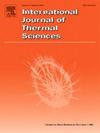Study of parameters affecting the cooling capacity of liquid jets by using OpenFoam as tool to solve the inverse heat transfer problem
IF 4.9
2区 工程技术
Q1 ENGINEERING, MECHANICAL
International Journal of Thermal Sciences
Pub Date : 2025-02-25
DOI:10.1016/j.ijthermalsci.2025.109797
引用次数: 0
Abstract
In this work, some of the parameters influencing the cooling capacity of a liquid jet impinging onto Inconel 718 and C45 plates were experimentally investigated under different conditions. The experiment comprises a high-speed camera to record the dynamics of the jet during the cooling process while an infrared camera was used to record the temperature field at the backward surface of the specimen plate. Jets consisting of water or oil-in-water emulsions were analysed as well as the influence of the oil concentration. Other parameters studied here include initial temperature of the plate, nozzle-to-plate distance, nozzle diameter, jet velocity, and impingement angle. The cooling performance was analysed by solving a full 3D inverse heat transfer problem (IHTP) with the Conjugate Gradient Method (CGM) implemented in a new solver in OpenFoam. The basic organization and implementation of the solver is shown, followed by its validation with a synthetic test case. Finally, the growth of the wetting front was analysed for different oil concentrations and a combination of nozzle diameters and jet velocities for the same flow rate. A linear correlation was observed between the Re and the critical heat flux (CHF) when using the same liquid. Furthermore, the estimation of the CHF when using different plate materials was shown to be possible by scaling it with the thermal effusivity of the materials.
求助全文
约1分钟内获得全文
求助全文
来源期刊

International Journal of Thermal Sciences
工程技术-工程:机械
CiteScore
8.10
自引率
11.10%
发文量
531
审稿时长
55 days
期刊介绍:
The International Journal of Thermal Sciences is a journal devoted to the publication of fundamental studies on the physics of transfer processes in general, with an emphasis on thermal aspects and also applied research on various processes, energy systems and the environment. Articles are published in English and French, and are subject to peer review.
The fundamental subjects considered within the scope of the journal are:
* Heat and relevant mass transfer at all scales (nano, micro and macro) and in all types of material (heterogeneous, composites, biological,...) and fluid flow
* Forced, natural or mixed convection in reactive or non-reactive media
* Single or multi–phase fluid flow with or without phase change
* Near–and far–field radiative heat transfer
* Combined modes of heat transfer in complex systems (for example, plasmas, biological, geological,...)
* Multiscale modelling
The applied research topics include:
* Heat exchangers, heat pipes, cooling processes
* Transport phenomena taking place in industrial processes (chemical, food and agricultural, metallurgical, space and aeronautical, automobile industries)
* Nano–and micro–technology for energy, space, biosystems and devices
* Heat transport analysis in advanced systems
* Impact of energy–related processes on environment, and emerging energy systems
The study of thermophysical properties of materials and fluids, thermal measurement techniques, inverse methods, and the developments of experimental methods are within the scope of the International Journal of Thermal Sciences which also covers the modelling, and numerical methods applied to thermal transfer.
 求助内容:
求助内容: 应助结果提醒方式:
应助结果提醒方式:


